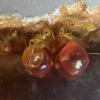- Formiculture.com
- Forums
- Gallery
- Members
- Member Map
- Chat

How to hibernate?
Started By
SurfingTangents
, Nov 20 2019 10:38 AM
9 replies to this topic
#1
 Offline
-
Posted November 20 2019 - 10:38 AM
Offline
-
Posted November 20 2019 - 10:38 AM
I live in Florida so our weather is a little different here.. I have pogonomyrmex badius I know they have some kind of pseudo hibernation not sure how that works? And I also have camponotus floridanus, and Camponotus Planatus. What temperature should I set the fridge?
#2
 Offline
-
Posted November 20 2019 - 10:42 AM
Offline
-
Posted November 20 2019 - 10:42 AM
The Floridan variety probably doesn't, but those further toward the north might go into diapause. Where in the state are you?
Spoiler
#3
 Offline
-
Posted November 20 2019 - 10:42 AM
Offline
-
Posted November 20 2019 - 10:42 AM
I don't believe any of these species actually hibernate, as I've seen both of those camponotus species in the middle of winter. If I were you I would keep them out, although the queens may take a break from laying eggs.
Also DON'T USE THE FRIDGE! It will kill these species as they're used to warmer climates.
Also DON'T USE THE FRIDGE! It will kill these species as they're used to warmer climates.
Edited by Manitobant, November 20 2019 - 10:44 AM.
- Martialis likes this
My journals:
Polyergus Mexicanus: https://www.formicul...gs/#entry175528
Lasius minutus: https://www.formicul...cs/#entry174811
Lasius latipes: https://www.formicul...gs/#entry206449
General acanthomyops journal: https://www.formicul...yops-with-eggs/
Polyergus Mexicanus: https://www.formicul...gs/#entry175528
Lasius minutus: https://www.formicul...cs/#entry174811
Lasius latipes: https://www.formicul...gs/#entry206449
General acanthomyops journal: https://www.formicul...yops-with-eggs/
#4
 Offline
-
Posted November 20 2019 - 10:44 AM
Offline
-
Posted November 20 2019 - 10:44 AM
read below
Edited by Martialis, November 23 2019 - 10:38 AM.
- TennesseeAnts likes this
Spoiler
#5
 Offline
-
Posted November 20 2019 - 2:20 PM
Offline
-
Posted November 20 2019 - 2:20 PM
It entirely depends on what part of the state you obtained the ants in, but Camponotus floridanus and Pogonomyrmex badius both have a winter diapause in most of Florida. North and central Floridian Pogonomyrmex badius and Camponotus floridanus go through a winter diapause in the wild, and for the badius it is best to replicate their natural environment as they can be very sensitive ants to keep. Assuming you're probably in central Florida, Camponotus floridanus won't really require a diapause to survive but allowing them to rest will promote a big egg batch as soon as the diapause is over.
As for the method of inducing diapause, you certainly don't want to put any Florida ants in a refrigerator.. unless it is turned off. To get the best temperatures for diapause, you can put their setup on a cold floor (I have mine on the floor of a closet) or you can set them in a window that faces north. For central Florida, 70 degrees is usually cold enough for them to slow or stop brood production, but anywhere in the range of 60-70F is best. You'll know when Camponotus are in diapause when there are no eggs or pupae left and the remaining larvae have a dull, slightly shriveled appearance and are no longer growing. You won't need to give the floridanus any protein when the larvae aren't growing, but try to keep their gasters full of carbohydrates during diapause. And I don't have much experience with Pogonomyrmex badius, but I am almost certain they go completely broodless for their diapause.
Also, C. floridanus is a bit different from a lot of other Florida Camponotus in that they don't really enter diapause automatically (which is why you have to induce it). There are some other species which have a distribution that reaches much farther north into the US, like castaneus, decipiens, pennsylvanicus, and nearcticus.. these species go into diapause automatically, usually without any change in temperature. Once that happens, you'd just place them in cooler temperatures and they'll become active when you warm them up again.
Camponotus planatus is an exotic ant from the tropics and does not exhibit a period of diapause at all.
Edited by Aaron567, January 9 2020 - 7:18 PM.
- Martialis, Lazarus, TennesseeAnts and 6 others like this
#6
 Offline
-
Posted November 20 2019 - 4:11 PM
Offline
-
Posted November 20 2019 - 4:11 PM
This is an excellently detailed response, Aaron! If only all questions on here were answered so thoroughly.
- Lazarus, TennesseeAnts, NickAnter and 1 other like this
"The ants are a people not strong, yet they prepare their meat in the summer." Prov. 30:25
Keep ordinary ants in extraordinary ways.
Keep ordinary ants in extraordinary ways.
#7
 Offline
-
Posted November 22 2019 - 10:32 AM
Offline
-
Posted November 22 2019 - 10:32 AM
I just put mine in the fridge. Not the freezer. Just make sure the species you are hibernating actually hibernate. I've made that mistake before and it sucked.
#8
 Offline
-
Posted November 22 2019 - 4:52 PM
Offline
-
Posted November 22 2019 - 4:52 PM
Aaron was really clear that no Florida ants should go in a fridge.
- Manitobant likes this
"The ants are a people not strong, yet they prepare their meat in the summer." Prov. 30:25
Keep ordinary ants in extraordinary ways.
Keep ordinary ants in extraordinary ways.
#9
 Offline
-
Posted November 22 2019 - 5:33 PM
Offline
-
Posted November 22 2019 - 5:33 PM
It entirely depends on what part of the state you obtained the ants in, but Camponotus floridanus and Pogonomyrmex badius both have a winter diapause in most of Florida. North and central Floridian Pogonomyrmex badius and Camponotus floridanus go through a winter diapause in the wild, and for the badius it is best to replicate their natural environment as they can be very sensitive ants to keep. Assuming you're probably in central Florida, Camponotus floridanus won't really require a diapause to survive but allowing them to rest will promote a big egg batch as soon as the diapause is over.
As for the method of inducing diapause, you certainly don't want to put any Florida ants in a refrigerator.. unless it is turned off. To get the best temperatures for diapause, you can put their setup on a cold floor (I have mine on the floor of a closet) or you can set them in a window that faces south. For central Florida, 70 degrees is usually cold enough for them to slow or stop brood production, but anywhere in the range of 60-70F is best. You'll know when Camponotus are in diapause when there are no eggs or pupae left and the remaining larvae have a dull, slightly shriveled appearance and are no longer growing. You won't need to give the floridanus any protein when the larvae aren't growing, but try to keep their gasters full of carbohydrates during diapause. And I don't have much experience with Pogonomyrmex badius, but I am almost certain they go completely broodless for their diapause.
Also, C. floridanus is a bit different from a lot of other Florida Camponotus in that they don't really enter diapause automatically (which is why you have to induce it). There are some other species which have a distribution that reaches much farther north into the US, like castaneus, decipiens, pennsylvanicus, and nearcticus.. these species go into diapause automatically, usually without any change in temperature. Once that happens, you'd just place them in cooler temperatures and they'll become active when you warm them up again.
Camponotus planatus is an exotic ant from the tropics and does not exhibit a period of diapause at all.
@Aaron567, that was an awesome and informative response. What did you mean by "induce diapause"? Just bringing them inside where it is cooler or is it more than that? I have several Camponotus floridanus colonies and this is my first year for both. Given I'm in Tampa (central Florida near the coast), I didn't think they would actually hibernate but it sounds like I was wrong. I still have pupae, but have noticed a sharp drop in brood size the last few weeks (especially since the recent cold snap).
#10
 Offline
-
Posted November 22 2019 - 5:54 PM
Offline
-
Posted November 22 2019 - 5:54 PM
@Aaron567, that was an awesome and informative response. What did you mean by "induce diapause"? Just bringing them inside where it is cooler or is it more than that? I have several Camponotus floridanus colonies and this is my first year for both. Given I'm in Tampa (central Florida near the coast), I didn't think they would actually hibernate but it sounds like I was wrong. I still have pupae, but have noticed a sharp drop in brood size the last few weeks (especially since the recent cold snap).
By that I just meant that they'd need a decent temperature drop to actually slow down or stop their brood production. If you keep them warm throughout the winter they'll continue to grow as normal whereas several of the native Camponotus enter diapause based on what time of the year it is, rather than the temperature.
- MrKotter likes this
1 user(s) are reading this topic
0 members, 1 guests, 0 anonymous users



















